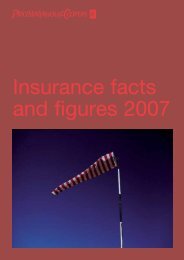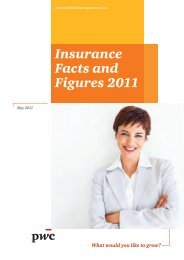Controlling fraud in the public sector - PricewaterhouseCoopers
Controlling fraud in the public sector - PricewaterhouseCoopers
Controlling fraud in the public sector - PricewaterhouseCoopers
You also want an ePaper? Increase the reach of your titles
YUMPU automatically turns print PDFs into web optimized ePapers that Google loves.
Reduced control?<br />
Of those government and state-owned enterprise<br />
respondents who perceived greater opportunities to<br />
commit <strong>fraud</strong> <strong>in</strong> <strong>the</strong> current environment, 55% believed<br />
that staff reductions meant fewer resources were used to<br />
support <strong>in</strong>ternal controls.<br />
F<strong>in</strong>ancial difficulties force organisations to reduce costs<br />
and explore possible efficiencies. Any result<strong>in</strong>g staff<br />
reductions can lead to reduced segregation of duties and<br />
less monitor<strong>in</strong>g of suspicious transactions and activities.<br />
This <strong>in</strong> turn weakens <strong>the</strong> <strong>in</strong>ternal control environment and<br />
can produce more opportunities for staff to commit <strong>fraud</strong>.<br />
Pay, performance and <strong>fraud</strong><br />
L<strong>in</strong>k<strong>in</strong>g pay to performance is ano<strong>the</strong>r possible driver of<br />
<strong>fraud</strong>ulent activity. Organisations need to be aware of<br />
<strong>the</strong> correlation between compensation structures and<br />
heightened <strong>fraud</strong> risk.<br />
Accord<strong>in</strong>g to <strong>the</strong> PwC Global Economic Crime Survey,<br />
<strong>public</strong> <strong>sector</strong> organisations with a performance-related pay<br />
structure for senior executives are almost twice as likely to<br />
have reported <strong>fraud</strong> (44%) than those that make no l<strong>in</strong>k<br />
between pay and performance (27%). There is a clear l<strong>in</strong>k<br />
between <strong>the</strong> <strong>in</strong>centive performance related pay structures<br />
created and <strong>the</strong> <strong>in</strong>stances of reported <strong>fraud</strong>.<br />
The NSW Auditor-General’s report echoed this view: “Fraud<br />
risks <strong>in</strong> <strong>the</strong> New South Wales <strong>public</strong> <strong>sector</strong> have been fur<strong>the</strong>r<br />
heightened by <strong>the</strong> rationalisation of ‘back office’ activities.<br />
If not planned well, gaps <strong>in</strong> vital <strong>in</strong>ternal controls can<br />
occur. Key controls such as <strong>the</strong> segregation of duties need<br />
to be ma<strong>in</strong>ta<strong>in</strong>ed, particularly <strong>in</strong> f<strong>in</strong>ance areas. The ‘back<br />
office’ is where many of <strong>the</strong> <strong>fraud</strong> controls need to be.” 7<br />
It is <strong>the</strong>refore important that organisations consider<br />
how <strong>the</strong>y employ <strong>the</strong>ir resources and ensure <strong>the</strong>y make<br />
sufficient <strong>in</strong>vestment <strong>in</strong> detection tools, such as data<br />
analytics, that can help fight <strong>fraud</strong>. This was highlighted <strong>in</strong><br />
<strong>the</strong> new Commonwealth Fraud Control Guidel<strong>in</strong>es which<br />
outl<strong>in</strong>ed requirements to detect <strong>fraud</strong> and recommended<br />
data m<strong>in</strong><strong>in</strong>g and match<strong>in</strong>g as a <strong>fraud</strong> detection technique. 8<br />
As shown <strong>in</strong> Figure 7, dim<strong>in</strong>ished IT controls and staff<br />
reductions <strong>in</strong> Australia across all <strong>in</strong>dustries are seen as<br />
present<strong>in</strong>g <strong>the</strong> greatest opportunities for perpetrators of<br />
economic crime.<br />
Figure 7: Factors given by respondents from all <strong>in</strong>dustries as<br />
contribut<strong>in</strong>g to <strong>in</strong>creased opportunities to commit <strong>fraud</strong><br />
Staff reductions have resulted <strong>in</strong> fewer<br />
resources deployed on <strong>in</strong>ternal controls<br />
Internal audit are be<strong>in</strong>g asked to<br />
do more work and/or with less staff<br />
Management is focused<br />
on survival of <strong>the</strong> bus<strong>in</strong>ess<br />
IT controls are weaken<strong>in</strong>g, mak<strong>in</strong>g us more<br />
vulnerable to external penetration<br />
Transfer of operations to new territories<br />
Enter<strong>in</strong>g <strong>in</strong>to new products<br />
Reduced regulatory oversight<br />
O<strong>the</strong>rs<br />
0% 10% 20% 30% 40% 50% 60% 70% 80%<br />
Global Asia Pacific Australia<br />
7 NSW Auditor-General’s Fraud Control Report, page 5<br />
8 Commonwealth Fraud Control Guidel<strong>in</strong>es 2011, page 15<br />
Fight<strong>in</strong>g <strong>fraud</strong> <strong>in</strong> <strong>the</strong> <strong>public</strong> <strong>sector</strong> 11
















